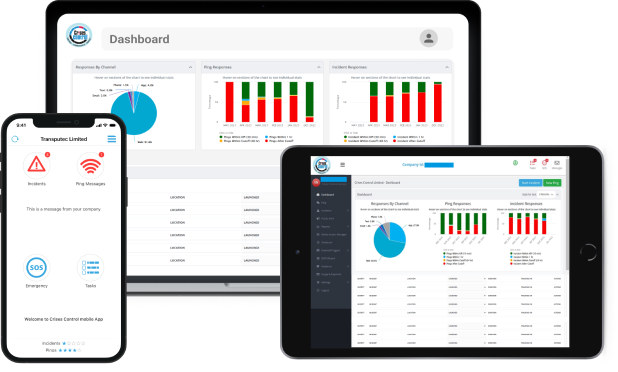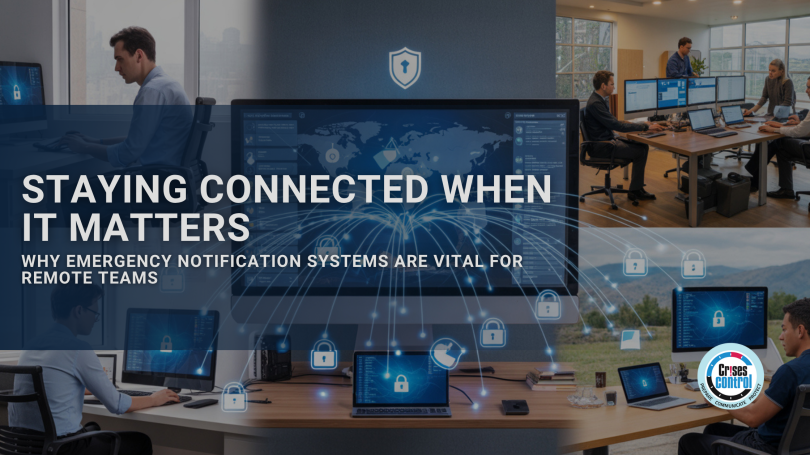Written by Asipe Nokenke | Marketing Assistant
Picture this: a ransomware attack locks your systems in the middle of the night. You need to alert your IT teams, loop in leadership, and protect customer data, but half the team is working remotely, some are in a different time zone, and no one’s answering emails.
This isn’t hypothetical. More teams are hybrid or fully remote, and when something serious happens, the old ways of communicating don’t hold up. You can’t rely on office announcements, quick huddles, or passing word around. And in the middle of a crisis, every minute counts.
So, what’s the answer?
You need a communication system that’s fast, reliable, and built for remote teams. One that doesn’t fall apart when stress levels rise. That’s where emergency notification systems come into their own.
What Goes Wrong in a Crisis?
When your team is spread across locations, time zones, and devices, getting urgent messages through is harder than it looks. Even companies with strong internal processes often run into the same issues:
- Delayed alerts: Someone sees the message hours later, too late to act.
- Scattered channels: A mix of WhatsApp, email, Slack, and SMS means messages get missed or buried.
- No visibility: You can’t tell who received the message, who read it, or who responded.
- No backup plan: If your first alert fails, what happens next?
The outcome? Confusion, lost time, and increased risk. In the worst-case scenario, this leads to physical harm, data loss, fines, or long-term damage to employee trust.
The Emotional Cost of Uncertainty
Beyond the logistics, there’s a human impact too. During a crisis, uncertainty hits hard, especially for remote staff who might feel isolated. Not knowing what’s happening or what to do increases stress.
Remote employees often ask themselves:
- Am I safe?
- Do I need to act?
- Is anyone managing the situation?
When there’s a proper emergency communication plan in place, it reassures your team that someone is in control. That clarity is just as important as any technical feature.
What a Good Emergency Notification System Should Actually Do
Let’s get specific. A good system doesn’t just send a message, it makes sure it gets through, gets understood, and gets acted on.
Here’s what you should expect:
- Multi-channel delivery: No one checks everything all the time. The best systems send alerts via mobile app, SMS, voice call, desktop notifications, and email simultaneously. That way, you’re not relying on one method to carry the message.
- Two-way communication: It’s not enough to push out alerts. People need to respond, report issues, or ask for help. The right system gives you live feedback, so you’re not guessing.
- Location-based targeting: If your London office is flooded, your Cape Town team doesn’t need the same alert. Geo-targeting ensures messages go to the people who actually need them.
- Message templates and workflows: In a real emergency, you won’t have time to draft messages from scratch. Pre-set templates and automated response plans save time and reduce errors.
- Live dashboards: You need to know who’s seen the message, who’s responded, and who hasn’t. Real-time dashboards give you that visibility instantly.
- Full audit trails: Whether for insurance, compliance, or learning, you’ll need a record. A proper system tracks every step who sent what, when, to whom, and what happened next.
A Real-World Example: Getting It Right
Let’s say you’re running IT for a multinational tech company. You’ve got teams across the UK, Europe, and South Africa. At 2 am, a ransomware attack strikes.
In the past, your team would’ve sent out emails, made phone calls, and hoped for the best.
Now, you’re using Crises Control.
Within minutes, the incident lead sends a pre-written alert via the Crises Control app.
- Messages go out across five channels at once: SMS, voice, email, mobile app, and desktop.
- Staff in affected regions get geo-targeted instructions.
- You can see in real time who has responded and who hasn’t.
- The incident is under control in under 30 minutes.
- No confusion. No wasted time. No loss of customer trust.
Why It’s Worth Getting Right
A solid emergency notification system doesn’t just feel reassuring it makes a real difference in how a crisis unfolds. When communication is fast, clear, and reliable, your team knows what to do and how to do it. Issues are contained quicker, decision-makers stay informed, and your people stay safe and confident. While exact results will vary depending on your organisation, teams that implement dedicated systems often report:
- Faster alert delivery than using manual emails or calls
- Fewer missed messages across departments
- Clearer oversight for leaders managing an unfolding situation
- Less confusion and downtime overall
The real value lies in coordination and clarity. It’s not about flooding inboxes, it’s about reaching the right people, with the right message, at the right time. If you’ve ever tried to manage a crisis through multiple apps, disjointed channels, and crossed wires, you already know how important this is. A purpose-built platform takes that stress off your shoulders and puts control back where it belongs.
Crisis Communication Is Business Continuity
Emergency messaging is one piece of a bigger picture. Systems like Crises Control don’t just send alerts, we support your entire business continuity strategy.
We help you:
- Define escalation paths: If someone doesn’t respond, who takes over?
- Run simulations and drills: Train your team in advance, not during the real thing.
- Access audit-ready logs: Ideal for insurance, regulators, or internal reviews.
- Stay legally compliant: From GDPR to health and safety, proving your response is just as important as doing it.
It’s not just about the alert. It’s about readiness, recovery, and resilience.
How to Build a Smarter Emergency Communication Plan
A great system is only as effective as the strategy behind it. Here’s how to make yours stronger:
- Know your risks: Think about what’s most likely to go wrong. Is it extreme weather? Cyberattacks? Supplier issues? Tailor your alerts to fit.
- Segment your staff: Different teams need different messages. What your warehouse team needs in a fire drill isn’t the same as your HR team working remotely.
- Prepare your messages: Don’t leave it until the heat is on. Write and test your templates now.
- Test the system regularly: Drills aren’t just for show. They make sure people recognise the alerts and know what to do.
- Learn from every incident: Use post-incident reports to review what worked, what didn’t, and how to improve.
Remote Doesn’t Have to Mean Disconnected
The rise of remote and hybrid work has transformed the way we operate. But it also introduced new risks. You can no longer rely on walking across the office or calling an all-hands meeting when something goes wrong. You need tools and processes that work across time zones, departments, and devices.
Crises Control was designed for this reality. It helps you:
- Coordinate quickly
- Communicate clearly
- Respond confidently
All while keeping your people safe and your operations moving.
Conclusion: People First, Always
When a crisis hits, your team wants two things: clear direction and the reassurance that someone is in charge. A strong emergency notification system delivers both.
It’s not just about avoiding downtime. It’s about showing that you value your people wherever they work from. And when employees feel protected and informed, they stay focused, loyal, and productive even when things go wrong.
That’s something no WhatsApp group or generic email chain can offer.
Ready to See It in Action?
Contact us today to request your free personalised demo of Crises Control.
Request a FREE Demo

